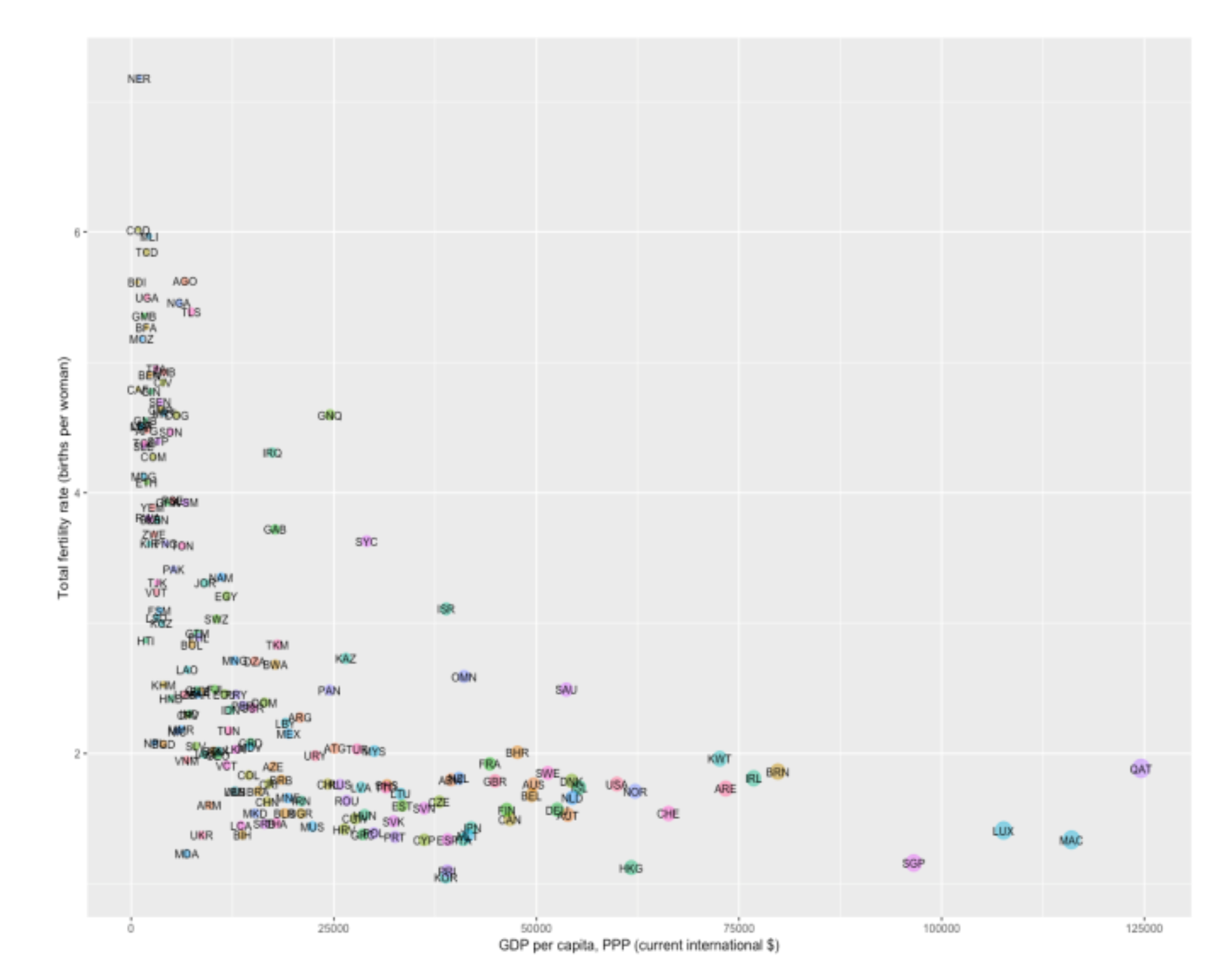The current brief introduces the general rationale behind fertility decisions and policy interventions. It summarizes the economic literature on the effects of different types of policy interventions on enhancing childbearing. The brief is followed by country reports presenting country-specific contexts, various policy challenges, implemented reforms and a discussion of other policy options covering childbearing.
First published at freepolicybriefs.org
Introduction to Economics of Childbearing
From an economic point of view, there are several potential reasons why public policy interventions concerning fertility may be beneficial for society and why – when left without support – decisions of parents might be suboptimal from the social point of view. In order to better understand these, one must first consider the intuition behind the theoretical economic approach to family relations in general and to fertility decisions in particular, much of which draws on the seminal contributions of Gary Becker (Becker & Lewis 1973; Becker & Tomes 1976).
In economics, goods are any real objects that satisfy people’s needs and typically come at some cost. Becker’s approach to the family extends this reasoning to human relations and presents decisions on partnership, divorce and family formation in the context of ‘economic’ trade-offs between costs and benefits. Since having children is associated with considerable costs (both in terms of money and time) as well as gains in a number of dimensions, the decision to have a child can be formulated as an economic decision. However, viewed from this perspective, the choice to have children turns out to be special in several dimensions.
Negative Income-Fertility Relationship and Low Fertility
One of the most robust observations regarding fertility is that – in contrast to many other types of expenditures – there is a strong negative association between earnings and the number of children (Figure 1). This negative income-fertility relationship has been observed in every developed nation, both when examined over time in relation to income growth and when looked at in a cross- country comparisons (see Jones et al. 2011). Figure 2 shows this relationship in a broad macro perspective: historically, as the world’s per capita GDP has grown fertility rates have tended to decline.
There are several potential drivers behind the above relationship. Two of the most established explanations are opportunity cost and quality- quantity trade-off, and they relate to several special features of the costs and benefits of having a child and the very nature of the family.
Figure 1. The relationship between total fertility rate and GDP per capita

Source: World Bank.
Figure 2. Trends in total fertility rate by region, 1950-2050.

Source: World Bank.
Money and Time Costs
A rather unique property of family formation is that costs related to childbearing are expressed both in terms of money and time. Because of the latter, high-earning parents face higher opportunity costs of the time necessary to raise a child. This might not only contribute to the aforementioned negative fertility-income relationship but has also been shown as one of the main reasons behind low fertility in developed countries. One of the most common policies used to increase fertility is money transfers which come in the form of family allowances, baby bonuses or tax credits. According to the UN Population Facts, at least 96% of developed nations have this type of policy. OECD countries, on average, spend around 4% of their GDP on this kind of assistance and the average effect of such interventions has been estimated to increase the total fertility rate (TFR) by 0.08 – 0.35 (Luci-Greulich & Thevenon 2011). The main reason why one needs to spend a lot of money to gain a relatively small increase in TFR is that low fertility is a «first world» problem, i.e. most of the targeted individuals are not bounded by the monetary costs of a child.
Policies that take the time-cost of children into account promise a higher potential effect in developed countries. For example, Raute (2019) uses German data to find an 18% increase in fertility among women with earnings above the median after the introduction of earnings- dependent paid maternity leave policy.
Quality — Quantity Trade-off
In economics, the idea that education, health and other factors increase human productivity and potential is conceptualized in a notion of “quality of human capital”. As the return on investment in human capital rises, parents may choose to have fewer children and focus their time and financial ‘investments’ in their quality. Some of the most convincing evidence on the strength of the quality- quantity trade-off was revealed using the data on twin births and on family sizes by Hanushek (1992) and Li et al. (2008).
Cultural Norms
Relatively recent research on the determinants of fertility has documented the substantial and persistent influence of cultural norms on fertility. This is reflected in the variation of fertility levels within countries among people of similar financial status, but coming from different cultural backgrounds. For example fertility levels among immigrants in the developed world tend to resemble those in their countries of origin (see, e.g. Beach & Hanlon 2019, Families and Societies 2015), and while cultural norms change and can also be affected by the policy environment (Bassi & Rasul 2017), there tends to be a substantial degree of time-dependence in how norms evolve and adjust.
Internal Costs and External Benefits
The last special feature of childbearing from an economic perspective is that although most of the costs in terms of time and money related to children are borne by parents, a large portion of future economic gains of an additional person is external to the family and benefits the wider society. When an adult enters the labor force, begins to produce goods and services for other people and pays taxes to the government, his or her parents would not be able to capture any significant portion of these benefits (Schoonbroodt & Tertilt 2014). From an economic perspective this suggests that the social value of children is higher than the private (parental) one. This situation is one of the main arguments for public policy intervention with regard to fertility. Whenever social benefits outweigh private benefits, subsidizing private choices may result in overall welfare improvements.
Fertility Enhancing Policies: What Works and What Doesn’t?
From the perspective of encouraging fertility, there is a wide range of options available to policymakers. On the one hand paid parental leave and subsidized childcare can mitigate the conflict between career and parenthood, while the introduction of paternal leave attempts at balancing out the time out of work between the two parents and at changing their allocation of time to childcare. On the other hand, child-related money transfers are aimed at reducing financial constraints on families who limit or postpone fertility because of their financial status.
In practice it is often hard to measure the effects of particular fertility-enhancing policies due to the lack of data and an absence of specific policy implementation designs, which would allow policy evaluation. However, there is evidence that fertility-enhancing policies can be successful in stimulating fertility. Luci-Greulich & Thevenon (2011) find that the most effective cash transfers are those targeted at the youngest children (aged 0-3), while those that are paid out around the birth appear to be less efficient. A number of studies prove the positive impact of transfers to families with children on fertility rates (d’Addio & d’Ercole 2005, Ermisch 1998, Milligan 2005, Whittington 1992, Whittington et al. 1990). Developments over the recent decades in Sweden are often used as an example of a successful family focused package, although given the multitude of different schemes running at the same time it is difficult to disentangle their specific implications (see Björklund 2006 for the evidence from Swedish policy reforms and Luci-Greulich & Thévenon 2013 for a broader overview of the existing research on fertility-enhancing policies).
Kalwij (2010) and Raute (2019) focus their attention on policies which alleviate career — parenthood trade-offs. Raute (2019) finds especially large effects of the adequate compensation of forgone earnings of high earning women (the author also contributes a comprehensive literature review of studies on the effects of alleviating the opportunity cost of children). Doepke and Kindermann (2016) complement these findings by providing evidence that fertility is especially responsive to policies that specifically reduce the childcare burden for women.
The evidence on the effects on fertility of another popular type of family policy, maternity leave, is less clear. Since most of the developed nations nowadays do have paid maternity leave, it is hard to measure the effect of its availability on the decision to have children. However, different durations of maternity leave across countries and changes in those durations allow economists to draw some conclusions. Although some researchers do find a positive effect of maternity leave duration (Adserà 2004), others fail to support this conclusion using different sources of data and experimental designs (d’Addio and d’Ercole 2005, Olivetti and Petrongolo 2017).
Concluding Remarks
A better understanding of the economic approach towards family formation and fertility can be helpful in thinking of a re-design of family-focused policy packages. It is beyond the scope of this brief to provide a full overview of the extensive body of economics research on this topic, but the evidence tends to suggest that a set of successful policy tools to encourage fertility is available. The basic concepts presented here can hopefully serve as background to a systematic and evidence-based discussion on public policy in this field. It should be noted that since parenthood is one of the most important choices in the life of many people, it is inherently related to many other individual choices and outcomes. Therefore, any policy aimed at increasing fertility will inevitably affect other important dimensions such as income inequality, taxation, gender equality, health and child development, among others. This means that any public intervention should always carefully consider its potential positive and negative side effects.
About FROGEE Policy Briefs
FROGEE Policy Briefs is a special series aimed at providing overviews and the popularization of economic research related to gender equality issues. Debates around policies related to gender equality are often highly politicized. We believe that using arguments derived from the most up to date research-based knowledge would help us build a more fruitful discussion of policy proposals and in the end achieve better outcomes.
The aim of the briefs is to improve the understanding of research-based arguments and their implications, by covering the key theories and the most important findings in areas of special interest to the current debate. The briefs start with short general overviews of a given theme, which are followed by a presentation of country-specific contexts, specific policy challenges, implemented reforms and a discussion of other policy options.
Attention
The authors do not work for, consult to, own shares in or receive funding from any company or organization that would benefit from this article, and have no relevant affiliations


